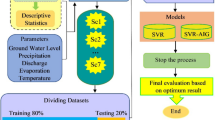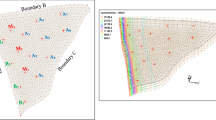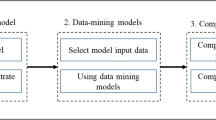Abstract
Predicting the extent of saltwater intrusion (SWI) into coastal aquifers in response to changing pumping patterns is a prerequisite of any groundwater management framework. This study investigates the feasibility of using support vector machine regression (SVMr), an innovative artificial intelligence-based machine learning algorithm for predicting salinity concentrations at selected monitoring wells in an illustrative aquifer under variable groundwater pumping conditions. For evaluation purpose, the prediction results of SVMr are compared with well-established genetic programming (GP) based surrogate models. SVMr and GP models are trained and validated using identical sets of input (pumping) and output (salinity concentration) datasets. The trained and validated models are then used to predict salinity concentrations at specified monitoring wells in response to new pumping datasets. Prediction capabilities of the two learning machines are evaluated using different proficiency measures to ensure their practicality and generalisation ability. The performance evaluation results suggest that the prediction capability of SVMr is superior to GP models. Also, a sensitivity analysis methodology is proposed for assessing the impact of pumping rates on salt concentrations at monitoring locations. This sensitivity analysis provides a subset of most influential pumping rates, which is used to construct new SVMr surrogate models with improved predictive capabilities. The improved prediction capability and the generalisation ability of the SVMr models together with the ability to improve the accuracy of prediction by refining the input set for training makes the use of proposed SVMr models more attractive. Prediction models with more accurate prediction capability makes it potentially very useful for designing large scale coastal aquifer management strategies.




Similar content being viewed by others
References
Alley WM, Healy RW, LaBaugh JW, Reilly TE (2002) Flow and storage in groundwater systems. Science 296:1985–1990
Bhattacharjya RK, Datta B (2009) ANN-GA-based model for multiple objective management of coastal aquifers. J Water Resour Plan Manag 135:314–322
Bhattacharjya RK, Datta B, Satish MG (2007) Artificial neural networks approximation of density dependent saltwater intrusion process in coastal aquifers. J Hydrol Eng 12:273–282
Chebrolu S, Abraham A, Thomas JP (2005) Feature deduction and ensemble design of intrusion detection systems. Comput Secur 24:295–307
Chevalier RF, Hoogenboom G, McClendon RW, Paz JA (2011) Support vector regression with reduced training sets for air temperature prediction: a comparison with artificial neural networks. Neural Comput Appl 20:151–159
Christelis V, Mantoglou A (2016) Pumping optimization of coastal aquifers assisted by adaptive metamodelling methods and radial basis functions. Water Resour Manag 30:5845–5859
Dhar A, Datta B (2009) Saltwater intrusion management of coastal aquifers. I: linked simulation-optimization. J Hydrol Eng 14:1263–1272
Farag A, Mohamed RM (2004) Regression using support vector machines: basic foundations Technical Report, Computer Vision and Image Processing Laboratory Electrical and Computer Engineering Department, University of Louisville 11(2):115–128
Foster JA (2001) Review: discipulus: a commercial genetic programming system. Genet Program Evolvable Mach 2:201–203
Gretton A, Doucet A, Herbrich R, Rayner PJ, Scholkopf B (2001) Support vector regression for black-box system identification. In: Statistical signal processing. Proceedings of the 11th IEEE signal processing workshop on, 2001. IEEE, pp 341–344
He Z, Wen X, Liu H, Du J (2014) A comparative study of artificial neural network, adaptive neuro fuzzy inference system and support vector machine for forecasting river flow in the semiarid mountain region. J Hydrol 509:379–386
Kordjazi A, Pooya Nejad F, Jaksa M (2015) Prediction of load-carrying capacity of piles using a support vector machine and improved data collection In: Ramsay G (ed) 12th Australia New Zealand Conference on Geomechanics, New Zealand. The New Zealand Geotechnical Society and the Australian Geomechanics Society, New Zealand pp 1–8
Kourakos G, Mantoglou A (2009) Pumping optimization of coastal aquifers based on evolutionary algorithms and surrogate modular neural network models. Adv Water Resour 32:507–521
Lin H-CJ, Richards DR, Yeh G-T, Cheng J-R, Cheng H-P (1997) FEMWATER: a three-dimensional finite element computer model for simulating density-dependent flow and transport in variably saturated media. DTIC Document, Vicksburg, MS 39180–6199
Liong S-Y, Lim W-H, Paudyal GN (2000) River stage forecasting in Bangladesh: neural network approach. J Comput Civ Eng 14:1–8
Liu Q, Chen C, Zhang Y, Hu Z (2011) Feature selection for support vector machines with RBF kernel. Artif Intell Rev 36:99–115
Loh W-L (1996) On Latin hypercube sampling. Ann Stat 24:2058–2080
Parveen N, Zaidi S, Danish M (2016) Support vector regression model for predicting the sorption capacity of lead (II). Perspect Sci 8:629–631
Roy DK, Datta B (2016) Fuzzy C-mean clustering based inference system for saltwater intrusion processes prediction in coastal aquifers. Water Resour Manag 31:355–376
Roy DK, Datta B (2017) Multivariate adaptive regression spline ensembles for management of multilayered coastal aquifers. J Hydrol Eng 22:04017031
Shu C, Ouarda T (2008) Regional flood frequency analysis at ungauged sites using the adaptive neuro-fuzzy inference system. J Hydrol 349:31–43
Sreekanth J, Datta B (2010) Multi-objective management of saltwater intrusion in coastal aquifers using genetic programming and modular neural network based surrogate models. J Hydrol 393:245–256
Sreekanth J, Datta B (2011) Comparative evaluation of genetic programming and neural network as potential surrogate models for coastal aquifer management. Water Resour Manag 25:3201–3218
Vapnik V, Golowich SE, Smola AJ (1997) Support vector method for function approximation, regression estimation and signal processing. In: Mozer MC, Jordan MI, Petsche. T (eds) neural informationprocessing systems 1996. MIT Press, Cambridge pp 281–287
Wang C, Duan Q, Gong W, Ye A, Di Z, Miao C (2014) An evaluation of adaptive surrogate modeling based optimization with two benchmark problems. Environ Model Softw 60:167–179
Wen Y, Cai C, Liu X, Pei J, Zhu X, Xiao T (2009) Corrosion rate prediction of 3C steel under different seawater environment by using support vector regression. Corros Sci 51:349–355
Westerhuis JA et al (2008) Assessment of PLSDA cross validation. Metabolomics 4:81–89
Wu C-H, Ho J-M, Lee D-T (2004) Travel-time prediction with support vector regression. IEEE Trans Intell Transp Syst 5:276–281
Yang H, Chan L, King I (2002) Support vector machine regression for volatile stock market prediction. In: International conference on intelligent data engineering and automated learning. Springer, pp 391–396
Yoon H, Jun S-C, Hyun Y, Bae G-O, Lee K-K (2011) A comparative study of artificial neural networks and support vector machines for predicting groundwater levels in a coastal aquifer. J Hydrol 396:128–138
Yu P-S, Chen S-T, Chang I-F (2006) Support vector regression for real-time flood stage forecasting. J Hydrol 328:704–716
Acknowledgments
The authors would like to thank James Cook University for supporting the first author through the James Cook University Postgraduate research scholarship program.
Author information
Authors and Affiliations
Corresponding author
Rights and permissions
About this article
Cite this article
Lal, A., Datta, B. Development and Implementation of Support Vector Machine Regression Surrogate Models for Predicting Groundwater Pumping-Induced Saltwater Intrusion into Coastal Aquifers. Water Resour Manage 32, 2405–2419 (2018). https://doi.org/10.1007/s11269-018-1936-2
Received:
Accepted:
Published:
Issue Date:
DOI: https://doi.org/10.1007/s11269-018-1936-2




